LEADERSHIP
LEADERSHIP
HERE ARE SOME OF OUR CURRENT THOUGHTS ON “Leadership” THROUGH THE HARRINGTON BRANDS PROCESS. WE HOPE YOU ENJOY, LEARN AND APPLY!
In this Solocast episode of Direct Application, host Matt Harrington breaks down a powerful leadership concept called the “Get Family” — four essential personalities you’ll find on every team or board: Get It Done, Get It Right, Get Along, and Get Appreciated. Whether you're leading a staff meeting, managing a board retreat, or trying to strengthen your team dynamics, this quick leadership lesson will help you better understand how to identify and honor different work styles—and how to help them function together in harmony.
Direct Application, a new podcast and video series hosted by leadership trainer and Harrington Brands founder Matt Harrington, officially launches today. Designed for leaders at every level, the podcast focuses on practical, people-centered leadership strategies that work—both in the office and in the community.
Kick off your strategic planning season with two essential tools: SWOT analysis and surveys. This blog explores how to facilitate meaningful SWOT sessions, engage stakeholders across sectors, and use dot voting to identify top priorities. Start with data-driven discovery to guide future decisions and build trust throughout your organization or community.
As we hit the middle of summer, organizations should start to prepare for a new fiscal year and big picture planning; this is an ideal season to engage in strategic planning. We often encourage our clients: before setting your sights on bold goals and new horizons, you need to ground your team in knowledge, insight, and shared understanding. That work begins with curiosity about your organization, its history, its people, and the context in which it operates.
In our Greenthumb Leadership framework, Stage 3 is called Disgruntled. These are your seasoned professionals. They’re knowledgeable. They’ve been in the system long enough to know how it works—and sometimes, how to work around it. But they’re tired. Jaded. Resistant. These are the overgrown plants in your garden. Once full of potential, they’ve picked up weeds, disease and bugs along the way: resentment, cynicism, and detachment. The real problem with Disgruntled C-suiters? They often hold the most power, most influence and most control. And, in that respect, they can be the most dangerous.
This post explores the delicate balance between accountability and empathy in leadership, especially in a time when staff are feeling burned out and undervalued. Drawing from Crucial Accountability and thought leader Dr. Jay Campbell, it outlines how leaders can hold people to high standards while still showing compassion. The key is moving beyond avoidance or aggression to have respectful, clear, and constructive conversations that build trust and drive results. True leadership lives in the tension between expectation and empathy—and that’s where real transformation begins.
In this post we explore how accountability drives organizational excellence and culture, inspired by Steve Jobs' iconic quote: “Be a yardstick of quality.” Drawing from the book Crucial Accountability and real-life leadership moments, he outlines how mindset, clarity, and consistent conversations shape high-performing teams. Learn why culture is built in the everyday "moments of truth," as leadership expert Jan Carlzon emphasized, and how to raise the bar without losing your team’s trust. Perfect for executives, team leaders, and HR professionals focused on improving accountability, trust, and performance.
In a world of nonstop noise, true leadership sometimes requires silence. This post explores how journaling and intentional reflection—anchored in the practices of Resonant Leadership—can deepen self-awareness, build resilience, and support authentic leadership growth. Drawing from real retreat experiences and the research of James Pennebaker and Brené Brown, it offers practical tips for starting a journaling habit that heals and empowers.
Influence in leadership begins with a grounded sense of self-confidence—not arrogance, but clarity about one’s values, voice, and impact. When leaders doubt their influence, it often stems from internal narratives rather than external evidence. By exploring personal strengths, seeking honest feedback, and aligning with purpose, leaders can reclaim their presence and lead with authentic influence.
In this post, I reflect on my panel presentation where I shared practical, low-cost strategies for becoming an employer of choice through trust, leadership flexibility, and purposeful engagement. I emphasized that retention is driven by relationships—not resumes—and introduces frameworks like CAMP motivation, Greenthumb Leadership, and belief-behavior conversations.
Over the past few months, we've explored the many dimensions of the Resilient Warrior Leader—a modern leader who draws from inner strength, leads with presence, and builds endurance for both the battlefield of business and the quiet moments of reflection. Now, as we close this powerful series, we offer a final credo and a call to action for those ready to embody resilience not as a buzzword—but as a way of life.
In this Resilient Warrior Leader post, we explore compassion as a vital internal compass for leaders navigating uncertainty and building trust. Using the L.E.A.D. framework—Look, Empathize, Acknowledge, Decide—readers are invited to slow down, pay attention, and take meaningful action rooted in empathy. The post emphasizes that compassion isn’t soft; it’s strategic, renewable, and essential for resilient, community-centered leadership.
Continuing our Resilient Warrior Leader entry, we explore hope as a structured, strategic leadership tool, not just a feel-good emotion. Drawing on C.R. Snyder’s Hope Theory, Brené Brown’s insights on resilience, and Jim Collins' Stockdale Paradox, the post shows how real hope is forged in struggle and grounded in action. Ultimately, hope—paired with faith—is positioned as the courageous, necessary energy leaders need to move teams forward, especially in uncertain times.
Practice alone isn’t enough; making practice a habit is where real transformation happens. True grit—the ability to persevere through adversity—and real resilience depends on small, repeated acts. Over time, these acts build into powerful capabilities.
This post explores the deep connection between leadership, passion, and perseverance, emphasizing that true passion often involves sacrifice and sustained effort. It highlights the importance of deliberate practice and renewal in avoiding burnout and achieving a state of flow. Ultimately, resilient leaders are those who pursue purpose with grit, balancing passion with intentional self-care and growth.
I’ve long been fascinated by the human body—its capacity for endurance, resilience, and renewal. It’s truly one of God’s greatest gifts: a self-healing, constantly adapting machine. But like any machine, if we don’t put gas in the tank, oil on the pistons, or do regular 10,000-mile tune-ups, we risk breakdown.
Leadership is no different.
The physical and emotional taxation of leadership is real—and too often overlooked.
In a time when fear-based, authoritarian leadership styles are resurging globally, this post reflects on the enduring value of authentic, hope-driven leadership rooted in empathy, humility, and service. Despite the current climate, there is a call on leaders and educators to continue nurturing a new generation that leads with compassion, courage, and integrity.
Many leaders fall into the trap of the Superhuman Syndrome, pushing themselves to exhaustion while ignoring the long-term costs to their well-being and effectiveness. This post explores how dissonant leadership and the constant chase for urgency can lead to burnout, while resonant leadership—rooted in emotional intelligence and renewal—fosters sustainable success. By embracing the Cycle of Sacrifice and Renewal, leaders can model resilience, elevate team performance, and lead with clarity and composure.
As we continue our Resilient Warrior series, it's important to start with self-awareness—understanding our patterns and recognizing how we respond under pressure. When we are overtaxed, overburdened, and exhausted, we often fall into default stress behaviors.
Are you the "Three-Ring Circus" Leader (Chaos Chaser), the "Iron Fortress" Leader (Stoic Under Pressure), the "Tsunami Shield" Leader (People-Pleaser), or the "Pressure Cooker" Leader (Procrastination Strategist)?
The runner trains, the player practices, the warrior studies—so why do we assume that leading in today’s challenging world requires anything less? Leadership today demands more than just assimilation, acceptance and mediocrity — it requires intentional training and practice, just like an elite athlete or seasoned warrior.
A soufflé perfectly captures the essence of a leader’s vision—it starts with a strong foundation, requires delicate preparation, and rises with care and precision to create something breathtaking. Like a great vision, it inspires, stretches boundaries, and demonstrates that with the right balance of ingredients, a remarkable outcome is achievable.
Motivation, much like a well-balanced dish, relies on the right blend of ingredients. The CAMP model—Competency, Autonomy, Meaningfulness, and Progress—is your recipe to keep your team energized and engaged. Missing even one component is like forgetting salt in a soup—it just doesn’t work. Let’s break it down.
Over the next few weeks, we’re taking a delightful detour from our in-depth writing to focus on our newest e-book, The Leadership Compote. Designed as a recipe book for leaders, this e-book offers simple, powerful, and fun “recipes” to inspire and guide great leadership.
While you can always download the full e-book, we invite you to follow along as we share a new recipe each week. And if you find this content helpful, the best way to support us is by sharing this post with another leader who might enjoy or benefit from it.
Easy, applicable and scrumptious leadership recipes for everyone. Sometimes it takes some creativity (and a touch of humor) to better understand key leadership principles. It’s our hope that this book, above all else, sparks some ah-ha (or even ha-ha) moments for you. Leadership should be loose, fun, and adaptable. As you read through these recipes, I hope you not only chuckle but also picture exactly what we’re talking about when we think of best leadership practices and take something meaningful away.
Over the past year, we’ve explored the shift from workplace culture to community, delving into themes like belonging, trust, adaptability, and leadership as service. Through concepts like the Upside-Down Community Leader, Greenthumb Leadership, and the Deep Ocean Model, we’ve examined how leaders can foster growth, navigate change, and address underlying beliefs. This journey has highlighted that leadership is intentional and requires continuous learning, with the hope of inspiring growth and meaningful connections in others.
Good food is all about timing, intention, and a willingness to experiment. Leadership is no different. So, this holiday, let’s take a detour from boring leadership jargon and straight into the heart of the kitchen—a place where raw ingredients transform into something magic. Great leadership, like great food, can feed the soul. Here are the essential ingredients for the perfect leadership dish.
Crafting a Leadership Mission Statement is a powerful way to align your purpose, values, and goals as a leader. By identifying what you are passionate about, what you excel at, and what drives success, you can create a clear and inspiring roadmap for 2025. Use this guide to develop a mission statement that motivates, adapts to new challenges, and empowers you to lead with confidence.
Remote and hybrid work models have reshaped the workplace, with high-performing leaders often excelling due to their autonomy, discipline, and results-oriented approach, while lower-performing employees may struggle without direct supervision. Research, such as the Stanford University study, highlights the benefits of hybrid work, particularly in enhancing productivity and retention, though challenges arise when remote work is poorly managed. The future of work requires organizations to balance flexibility and accountability, fostering environments that empower diverse employees and adapt to changing expectations.
This post explores the critical role of strategic planning and visioning in helping organizations navigate uncertainty and long-term challenges. It emphasizes the importance of staying at a strategic level, resisting the pull toward immediate tactical fixes, and focusing on the pillars that drive success: leadership, innovation, operations, and customer focus. With actionable steps and insights, it provides a framework for crafting meaningful, future-oriented plans that transform strategic dreams into achievable realities.





























In this episode of Direct Application, Matt Harrington breaks down the One Page Strategy (OPS) - a simple but powerful tool to turn big ideas into real action. If your strategic vision has ever stalled after a board meeting or team presentation, it might not be the idea - it might be how you're delivering (or showcasing) your idea.